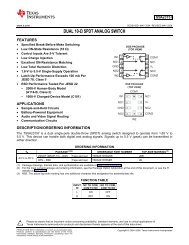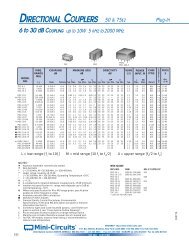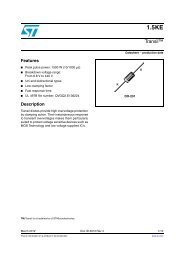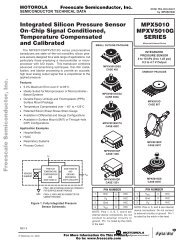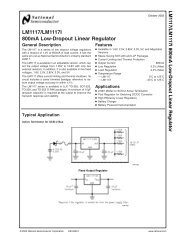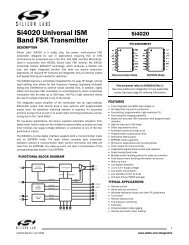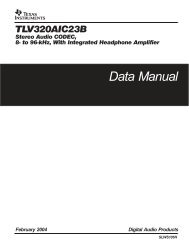LM809/LM810 3-Pin Microprocessor Reset Circuits
LM809/LM810 3-Pin Microprocessor Reset Circuits
LM809/LM810 3-Pin Microprocessor Reset Circuits
Create successful ePaper yourself
Turn your PDF publications into a flip-book with our unique Google optimized e-Paper software.
<strong>LM809</strong>/<strong>LM810</strong>Applications InformationBenefits of Precision <strong>Reset</strong> ThresholdsA microprocessor supply supervisor must provide a resetoutput within a predictable range of the supply voltage. Acommon threshold range is between 5% and 10% below thenominal supply voltage. The 4.63V and 3.08V options of the<strong>LM809</strong>/810 use highly accurate circuitry to ensure that thereset threshold occurs only within this range (for 5V and 3.3Vsupplies). The other voltage options have the same tighttolerance to ensure a reset signal for other narrow monitorranges. See Table 1 for examples of how the standard resetthresholds apply to 3V, 3.3V, and 5V nominal supply voltages.Negative-Going V CC TransientsThe <strong>LM809</strong>/810 are relatively immune to shortnegative-going transients or glitches on V CC . Figure 2 showsthe maximum pulse width a negative-going V CC transientcan have without causing a reset pulse. In general, as themagnitude of the transient increases, going further below thethreshold, the maximum allowable pulse width decreases.Typically, for the 4.63V and 4.38V version of the <strong>LM809</strong>/810,aV CC transient that goes 100mV below the reset thresholdand lasts 20µs or less will not cause a reset pulse. A 0.1 µFbypass capacitor mounted as close as possible to the V CCpin will provide additional transient rejection.TABLE 1. <strong>Reset</strong> Thresholds Related to CommonSupply Voltages<strong>Reset</strong>Threshold3.0V 3.3V 5.0V4.63 ± 3% 90 - 95%4.38 ± 3% 85 - 90%4.00 ± 3% 78 - 82%3.08 ± 3% 90 - 95%2.93 ± 3% 86 - 90%2.63 ± 3% 85 - 90% 77 - 81%2.45 ± 3% 79 - 84% 72 - 76%Ensuring a Valid <strong>Reset</strong> Output Down to V CC =0VWhen V CC falls below 1V, the <strong>LM809</strong> RESET output nolonger sinks current. A high-impedance CMOS logic inputconnected to RESET can therefore drift to undeterminedvoltages. To prevent this situation, a 100kΩ resistor shouldbe connected from the RESET output to ground, as shown inFigure 1.A 100kΩ pull-up resistor to V CC is also recommended for the<strong>LM810</strong>, if RESET is required to remain valid for V CC< 1V.10105709FIGURE 2. Maximum Transient Duration withoutCausing a <strong>Reset</strong> Pulse vs. <strong>Reset</strong> ComparatorOverdriveInterfacing to µPs with Bidirectional <strong>Reset</strong> <strong>Pin</strong>s<strong>Microprocessor</strong>s with bidirectional reset pins, such as theMotorola 68HC11 series, can be connected to the <strong>LM809</strong>RESET output. To ensure a correct output on the <strong>LM809</strong>even when the microprocessor reset pin is in the oppositestate, connect a 4.7kΩ resistor between the <strong>LM809</strong> RESEToutput and the µP reset pin, as shown in Figure 3. Buffer the<strong>LM809</strong> RESET output to other system components.10105710FIGURE 1. RESET Valid to V CC = Ground Circuit10105711FIGURE 3. Interfacing to <strong>Microprocessor</strong>s withBidirectional <strong>Reset</strong> I/Owww.national.com 6



